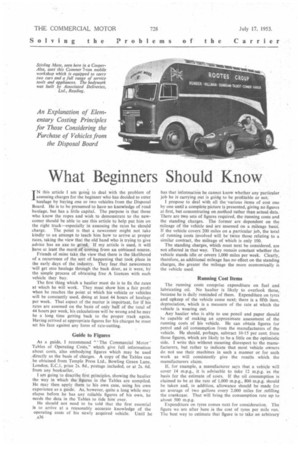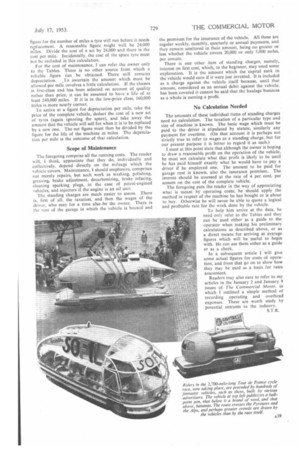What Beginners Should Know
Page 54

Page 57

If you've noticed an error in this article please click here to report it so we can fix it.
IN this article I am goini to deal with the problem of assessing charges for the beginner who has decided to enter haulage by buying one or two vehicles from the Disposal Board. He is to be presumed to have no knowledge of road haulage, but has a little capital. The purpose is that those who know the ropes and wish to demonstrate to the newcomer should he able to use this article to help put him on the right track—especially in assessing the rates he should
charge. The point is that a newcomer might not take kindly to an attempt to teach him how to arrive at proper rates, taking the view that the old hand who is trying to give Advice has an axe to grind. If my article is used, it will have at least the merit of coming from an unbiased source. Friends of mine take the view that there is the likelihood of a recurrence of the sort of happening that took place in the early days of the industry. They fear that newcomers Will get into haulage through the back door, as it were, by the simple process of obtaining free A licences with each vehicle they buy.
The first thing which a haulier must do is to fix the rates at which he will work. They must show him a fair profit when he reaches the point at which his vehicle or vehicles will be constantly used, doing at least 44 hours of haulage per week. That aspect of the matter is important, for if his rates are assessed on the basis of only half of the total of 44 hours per week, his calculations will be wrong and he may he a long time getting back to the proper track again_ Having arrived at appropriate figures for his charges he must set his face against any form of rate-cutting.
Guide to Figures
As a guide, I recommend "'The Commercial Motor' Tables of Operating Costs," which give full information about costs, also embodying figures which may be used directly as the basis of charges. A copy of the Tables can be obtained from Temple Press Ltd., Bowling Green Lane. London, E.C.1, price 2s. 8d., postage included, or at 2s. 6d.
from any bookseller. '
I am going to describe first principles, showing the haulier the way in which the figures in the Tables are compiled. He may then apply them to his own case, using his own experience as a guide. As, however, quite a long while may elapse before he has any reliable figures of his own, he needs the data in the Tables to tide him over.
He should not need to be told that the first essential is to arrive at a reasonably accurate knowledge of the operating costs of his newly acquired vehicle. Until he ..436 has that information he cannot know whether any particular job he is carrying out is going to be profitable or not.
I propose to deal with all the various items of cost one by one until a complete picture is presented, giving no figures at first, but concentrating on method rather than actual data. There are two sets of figures required, the running costs and the standing charges. The former are dependent on the mileage of the vehicle and are assessed On a mileage basis.. If the vehicle covers 200 miles on a particular job, the total of running costs involved will be twice those relating to a similar contract, the mileage of which is only 100.
The standing charges, whieh must next be considered, are not affected in that way. They remain constant whether the vehicle stands idle or covers 1,000 miles per week. Clearly, therefore, as additional mileage has no effect on the standing charges, the greater the mileage the more economically is the vehicle used.
Running Cost Items The running costs comprise expenditure on fuel and. lubricating oil. No haulier is likely to overlook those, because he is daily reminded of them. Expenditure on tyres and upkeep of the vehicle come next; there is a fifth item, depreciation, which is a measure of the rate at which the vehicle is wearing out.
Any haulier who is able to use pencil and paper should be capable of making an approximate assessment of the running costs of his vehicle. He can obtain figures for petrol and oil consumption from the manufacturers of the vehicle. He should, perhaps, subtract 10-15 per cent, from those figures, which are likely to be a little on the optimistic side. I write this without meaning disrespect to the manufacturers, but rather to indicate that most vehicle owners do not use their machines in such a manner or for such work as will consistently give the results which the manufacturers claim.
If, for example, a manufacturer says that a vehicle will cover 14 m.p.g., it is advisable to take 12 m.p.g. as the basis for the estimate of costs. If the oil consumption is claimed to be at the rate of 1,000 m.p.g., 800 m.p.g should be taken and, in addition, allowance should be made for an average of two gallons every 2,000 miles for refilling the crankcase. That will bring the consumption rate up to about 500 m.p.g.
Expenditure on tyres comes next for consideration. The figure we are after here is the cost of tyres per mile run. The best way to estimate that figure is to take an arbitrary
figure for the number of miles a tyre will run before it needs replacement. A reasonable figure might well be 24,000 miles. Divide the cost of a set by 24,000 and there is the cost per mile. Incidentally, the cost of the spare tyre must not be included in this calculation.
For the cost of maintenance, I can refer the owner only to the Tables, There is no other source from which a reliable figure can be obtained. There still remains depreciation. ,To ascertain the amount which must be allowed per mile involves a little calculation. If the chassis is first-class and has been selected on account of quality rather than price, it can be assumed to have a life of at least 240,000 miles. If it is in the low-price class, 160,000 miles is more nearly correct.
To arrive at a figure for depreciation per mile, take the price of the complete vehicle, deduct the cost of a new set of tyres (again ignoring the spare), and take away the amount that the vehicle will sell for when it is to be replaced by a new one. The net figure must then be divided by the figure for the life of the machine in miles. The depreciation per mile is the outcome of that calculation.
Scope of Maintenance
The foregoing comprise all the running costs. The reader will, I think, appreciate that they do, individually and collectively, depend directly on the mileage which the vehicle covers. Maintenance, I should emphasize, comprises not merely repairs, but such work as washing, polishing, greasing, brake adjustment, decarbonizing, brake refacing, cleaning sparking plugs, in the case of petrol-engined vehicles, and injectors if the engine is an oil unit.
The standing charges are much easier to assess. There is, first of all, the taxation, and then the wages of the driver, who may for a time also be the owner. There is the rent of the garage in which the vehicle is housed and the premium for the insurance of the vehicle. All these are regular weekly, monthly, quarterly or annual payments, and they remain unaltered in their amount, being no greater or less whether the vehicle covers 20,000 or only 5,000 miles, per annum.
There is one other item of standing charges, namely, interest on first cost, which, to the beginner, may need some explanation. It is the amount which the capital sunk in the vehicle would earn if it were just invested. It is included as a charge against the vehicle itself because, until that amount, considered as an annual debit against the vehicle, has been covered it cannot be said that the haulage business as a whole is earning a profit.
No Calculation Needed
The amounts of these individual items of standing charges need no calculation. The taxation of a particular type and size of machine is known. The basic wage which must be paid to the •driver is stipulated by statute, similarly any payment for overtime. (On that account it is perhaps not strictly true to refer to wages as a standing charge, but for our present purpose it is better to regard it as such.)
I must at this point state that although the owner is hoping to draw a reasonable profit on the operation of the vehicle, he must not calculate what that profit is likely to be until he has paid himself exactly what he would have to pay a driver if he employed one. The amount to be paid for garage rent is known, also the insurance premium. The interest should be assessed at the rate of 4 per cent, per annum on the cost of the complete vehicle.
The foregoing puts the reader in the way of appreciating what is meant by operating costs; he should apply the method in respect of the machine he has bought or is about to buy. Otherwise he will never be able to quote a logical and profitable rate for the work done by the vehicle.
To help him arrive at the data, he need only refer to the Tables and they can be used either as a guide to the operator when making his preliminary calculations as described above, or as a direct means for arriving at average figures which will be useful to begin with. He can use them either as a guide or as a check.
In a subsequent article I will give some actual figures for costs of operation, and from that go on to show how they may be used as a basis for rates assessment.
Readers may also care to refer to my articles in the January 2 and January 9 issues of The Commercial Motor, in which I outlined a simple method of recording operating and overhead expenses. These are worth study by potential entrants to the industry. S.T.R.




















































































